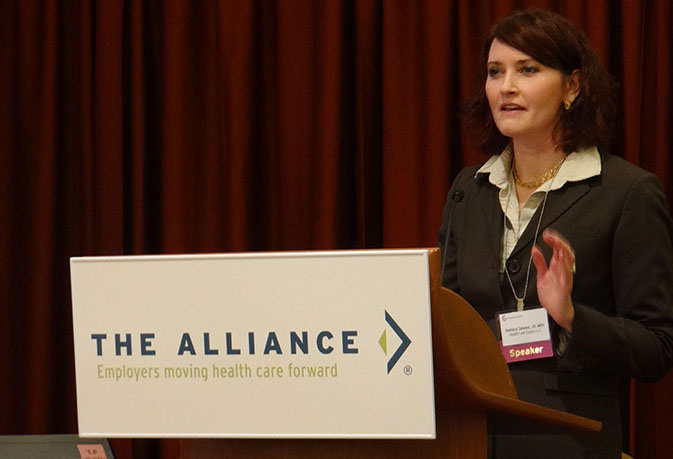
Do You Have ‘Compliance Anxiety’? Understanding ‘Wellness Law’ Can Help
The latest developments in “wellness law” were highlighted by Barbara Zabawa, attorney and founder of the Center of Health Law Equity, LLC. External Link. Opens in new window., at The Alliance Learning Circle on “Wellness Success in the workplace” at Monona Terrace on Jan. 21.
Zabawa explained that “wellness law” has not been officially declared a legal subspecialty, but it is an apt term to describe the “dozen laws out there” that impact wellness program design.
blog continues below video
‘Compliance Anxiety’
Complying with those laws has created “compliance anxiety,” Zabawa said, citing a study that shows that half of human resources professionals feel anxious about it.
“There is a cure: preventive law,” Zabawa said. “One of its primary tenets is to know the purpose of the law.”
Laws that impact wellness programs aim to:
- Prevent discrimination
- Prevent insensitivity to people’s needs, including the need for privacy
- Respond to people’s desire to participate in workplace activities and earn rewards from wellness programs.
“We can’t all be triathletes, but we all want to feel good,” Zabawa said.
The “Group Health Plan” Issue
It’s crucial for an employer to know whether their wellness plan is part of a group health plan. A group health plan provides medical care to employees and their dependents, either directly or by providing access to health insurance benefits.
“Medical care” means providing care that is related to the individual’s physical condition or state of health and/or relates to the relief or alleviation of health or medical problems, Zabawa said. But the term “medical care” does not apply to a program that only furthers general good health, such as fitness classes or nutrition classes.
The distinction is important, because group health plans must comply with a longer list of regulations.
Group Health Plans Must Comply With: |
Non-Group Health Plans Must Comply With: |
| ADA | ADA |
| GINA | GINA |
| FLSA | FLSA |
| ADEA | ADEA |
| IRC | IRC |
| Title VII | Title VII |
| State Laws | State Laws |
| HIPAA | |
| ACA | |
| ERISA | |
| COBRA |
Source: Barbara Zabawa, Center for Health Law Equity,
LLC
HIPAA and ACA Rules
Health Insurance Portability and Accountability Act (HIPAA). External Link. Opens in new window. and Affordable Care Act (ACA) rules have a significant impact on wellness law. HIPAA nondiscrimination rules prohibit discrimination by group health plans based on “health factors,” but make an exception for wellness programs if they follow specific rules.
To qualify for that exception, employers must offer any participatory program to “similarly situated” individuals. If they do, there is no limit on the financial incentive linked to the program.
If the program is designed to be “health contingent,” it must meet a five-factor test:
- Employees must be able to qualify for the reward at least once a year
- The total reward may not exceed 30 percent of the total cost of coverage, which increases to 50 percent for a tobacco prevention program
- A “reasonable design” must be used to promote health or prevent disease.
- The full reward must be available to all similarly situated individuals, with a reasonable alternative or waiver for those who cannot meet the standard due to a health condition. The employer must help find “reasonable alternatives” and pay for them.
- The reasonable alternative or waiver must be disclosed in plan materials that describe the wellness program.
ADA Proposed Rules and Court Rulings
Recent Equal Employment Opportunity Commission (EEOC). External Link. Opens in new window. challenges to employers have cited the Americans with Disabilities Act (ADA). External Link. Opens in new window. and the Genetic Information Nondiscrimination Act (GINA). External Link. Opens in new window.. Zabawa wryly described these as the “more fun” laws for wellness compliance.
ADA rules prohibit employers from discriminating on the basis of disability which includes requiring medical examinations. The definition of “medical examinations” includes procedures and tests that offer information on an employee’s health. Under ADA rules, an employer must provide equal opportunity for disabled employees to participate in programs and offer reasonable accommodations.
The ADA provides an exception for “voluntary” exams provided as part of an employee wellness program. EEOC has previously said a program was “voluntary” as long as the employer did not require participation nor penalize employees who did not participate.
The EEOC issued proposed ADA rules in April 2015, which aimed to:
- Align the ADA with the ACA by imposing a 30 percent incentive limit.
- Impose the incentive limit on participatory programs.
- Require a notice to employees regarding medical information collection and privacy and security protections related to wellness information.
The Flambeau Case Impact
“I think the Flambeau decision turns these proposed ADA rules on their head,” Zabawa said, referring to the Federal District Court for the Western District of Wisconsin decision in the EEOC v. Flambeau case that was issued on Dec. 31, 2015. Flambeau, a plastics manufacturer based in Baraboo, Wis., is a member of The Alliance cooperative.
The Flambeau decision, which was favorable to the employer, was based on the ADA’s provision of a “safe harbor” for administering the terms of a “bona fide benefit plan.” This safe harbor allows group health plans to ask medical-related questions and conduct medical exams. Zabawa said the safe harbor precludes the application of the “voluntary” standard.
“It was this safe harbor that won the day in the Flambeau case, so keep this safe harbor in mind,” Zabawa advised.
One EEOC case against an employer, Orion Energy, is still awaiting a decision. Zabawa said that because this case addresses issues that are similar to the issues in EEOC v. Flambeau, the EEOC may choose to settle out of court rather than wait for a decision.
GINA Issues
Within the GINA rules, Zabawa cited two titles to watch: Title I for group health plans and Title II for employers. These rules aim to protect employees and dependents from discrimination based on genetic information.
Zabawa shared these helpful tips for avoiding GINA noncompliance.
Do not tie financial incentives to participation in health assessments or biometric screening of the employee’s children.
- Do not ask questions about an employee’s family medical history.
- If you do ask questions about an employee’s family medical history, make sure you:
- Get the employee’s written authorization.
- Do not tie financial rewards to answering thequestion.
- Ask the question after open enrollment ends.
Moving Forward
Zabawa’s presentation made it clear that the issues and rules involved in wellness law are wide-ranging and still evolving. For employers who want to use wellness programs to improve employee health, allaying “compliance anxiety” is likely to involve ongoing awareness of the outcomes of court cases, the latest proposed rules and other developments that impact wellness law.
Steps to Compliance:
- Read the special update. External Link. Opens in new window. on the federal court decisions in the EEOC v. Flambeau case provided by the Center for Health Law Equity
- Use Barbara Zabawa’s Legal Compliance Checklist. External Link. Opens in new window. to guide your wellness program.
- Watch a video. External Link. Opens in new window. about Flambeau’s approach to employee health benefits.







